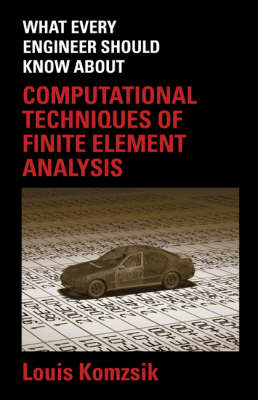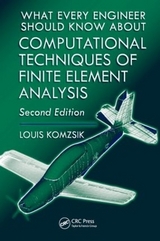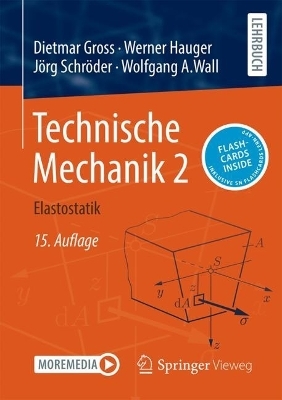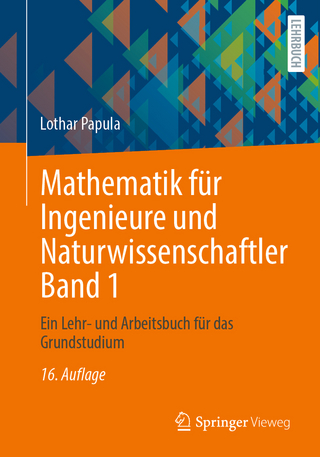
What Every Engineer Should Know About Computational Techniques of Finite Element Analysis
Taylor & Francis Ltd (Verlag)
978-0-8493-3563-1 (ISBN)
- Titel erscheint in neuer Auflage
- Artikel merken
Finite element analysis (FEA) has become the dominant tool of analysis in many industrial fields of engineering, particularly in mechanical and aerospace engineering. This process requires significant computational work divided into several distinct phases. What Every Engineer Should Know About Computational Techniques of Finite Element Analysis offers a concise, self-contained treatment of FEA and all of the tools needed for efficient use and practical implementation.
This book provides you with a walk-through of the process from the physical model to the computed solution. Based on the author's thirty years of practical experience in finite element analysis in the shipbuilding, aerospace, and automobile industries, it describes the transformation of the physical problem into a mathematical model, reduction of the model to a more efficient, numerically solvable form, and the solution of the problem using specific computational techniques. The author discusses time and frequency domain solutions as used in practice, as well as the representation of the computed results.
What Every Engineer Should Know About Computational Techniques of Finite Element Analysis serves as a to-the-point guide to using or implementing FEA for both beginners and everyday users who must apply the finite element method to your daily work. The techniques can be easily executed in most available FEA software packages.
NUMERICAL MODEL GENERATION
Finite Element Analysis
Solution of Boundary Value Problems
Finite Element Shape Functions
Finite Element Basis Functions
Assembly of Finite Element Matrices
Element Matrix Generation
Local to Global Coordinate Transformation
A Quadrilateral Finite Element
References
Finite Element Model Generation
Spline Approximation
Geometric Modeling Objects
Geometric Model Discretization
Delaunay Mesh Generation
References
Modeling of Physical Phenomena
Lagrange's Equations of Motion
Continuum Mechanical Systems
Finite Element Analysis of Elastic Continuum
A Tetrahedral Finite Element
Equation of Motion of Mechanical System
Transformation to Frequency Domain
References
Constraints and Boundary Conditions
The Concept of Multi-Point Constraints
The Elimination of Multi-Point Constraints
The Axial Bar Element
The Concept of Single Point Constraints
The Elimination of Single Point Constraints
References
Singularity Detection of Finite Element Models
Local Singularities
Global Singularities
Massless Degrees of Freedom
Industrial Case Studies
References
COMPUTATIONAL REDUCTION TECHNIQUES
Matrix Factorization and Linear System Solution
Finite Element Matrix Reordering
Sparse Matrix Factorization
Multifrontal Factorization
Linear System Solution
Distributed Factorization and Solution
Factorization Case Study
References
Static Condensation
Single Level, Single Component Condensation
Computational Example
Single Level, Multiple Component Condensation
Multiple Level Static Condensation
Static Condensation Case Study
References
Spectral Computations
Spectral Transformation
Lanczos Reduction
Generalized Eigenvalue Problem
Eigenvalue Computation
Distributed Eigenvalue Computation
Normal Modes Analysis Case Study
Complex Spectral Computations
Complex Modes Analysis Case Study
Dense Eigenvalue Analysis
Householder Reduction Techniques
Tridiagonal Reduction
Reduction to Hessenberg Form
References
Dynamic Reduction
Single Level, Single Component Dynamic Reduction
Accuracy of Dynamic Reduction
Computational Example
Single Level, Multiple Component Dynamic Reduction
Multiple Level Dynamic Reduction
Multibody Analysis Application
References
Component Modal Synthesis
Single Level, Single Component Modal Synthesis
Mixed Boundary Component Mode Reduction
Computational Example
Single Level, Multiple Component Modal Synthesis
Multiple Level Modal Synthesis
Component Modal Synthesis Case Study
References
ENGINEERING SOLUTION COMPUTATIONS
Modal Solution Technique
Modal Reduction
Truncation Error in Modal Reduction
The Method of Residual Flexibility
The Method of Mode Acceleration
Coupled Modal Solution Application
References
Transient Response Analysis
The Central Difference Method
The Newmark Method
Starting Conditions and Time Step Changes
Stability of Time Integration Techniques
Transient Solution Case Study
References
Frequency Domain Analysis
Direct Frequency Response Analysis
Reduced Order Frequency Response Analysis
Accuracy of Reduced Order Solution
Frequency Response Case Study
References
Nonlinear Analysis
Introduction to Nonlinear Analysis
Newton-Raphson Methods
Quasi-Newton Iteration Techniques
Convergence Criteria
Computational Example
Nonlinear Dynamics
References
Sensitivity and Optimization
Design Sensitivity
Design Optimization
Planar Bending of the Bar
Computational Example
Eigenfunction Sensitivities
Variational Analysis
References
Engineering Result Computations
Displacement Recovery
Stress Calculation
Nodal Data Interpolation
Level Curve Computation
Engineering Results Case Study
References
Closing Remarks
Annotation
Index
| Erscheint lt. Verlag | 1.3.2005 |
|---|---|
| Zusatzinfo | 500 equations; 14 Tables, black and white; 49 Illustrations, black and white |
| Verlagsort | London |
| Sprache | englisch |
| Maße | 152 x 229 mm |
| Gewicht | 522 g |
| Themenwelt | Mathematik / Informatik ► Mathematik ► Angewandte Mathematik |
| Technik ► Elektrotechnik / Energietechnik | |
| ISBN-10 | 0-8493-3563-9 / 0849335639 |
| ISBN-13 | 978-0-8493-3563-1 / 9780849335631 |
| Zustand | Neuware |
| Informationen gemäß Produktsicherheitsverordnung (GPSR) | |
| Haben Sie eine Frage zum Produkt? |
aus dem Bereich



